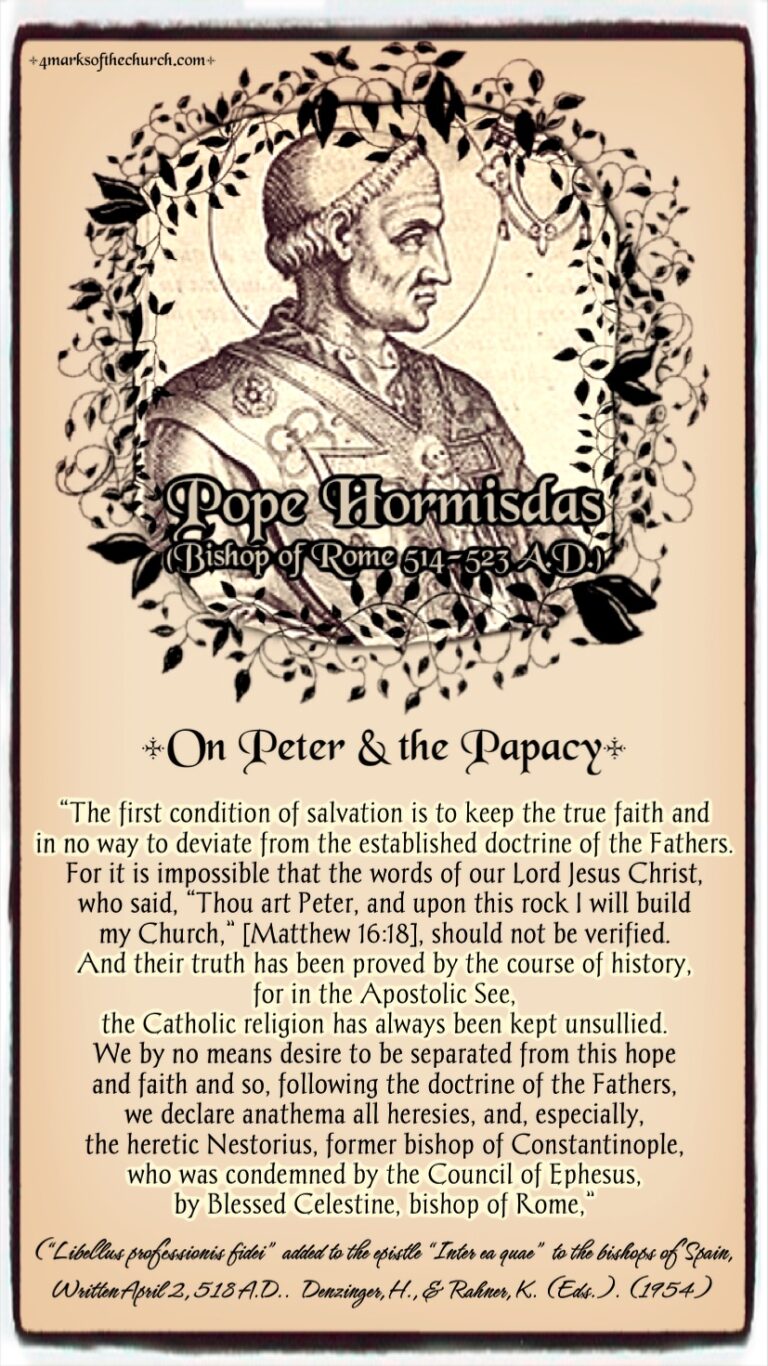Pope Hormisdas
Scroll for quotes→


Pope Hormisdas (450 – 523) was the bishop of Rome from 20 July 514 to his death. Upon becoming pope, one of Hormisdas’ first actions was to remove the last vestiges of the schism in Rome, receiving back into the Church those adherents of the Laurentian party who had not already been reconciled. He then put his efforts towards restoring communion between the Sees of Rome and Constantinople caused by the Acacian schism, which was the result of Acacius of Constantinople’s efforts to placate the Monophysites and and Emperor Zeno’s unsuccessful attempt to reconcile the parties with the edict of Henotikon, which endorsed the condemnations of Eutyches and Nestorius made at Chalcedon and explicitly approved the twelve anathemas of Cyril of Alexandria, but avoided any definitive statement on whether Christ had one or two natures, attempting to appease both sides of the dispute.
In an effort to resolve the schism, Emperor Anastasius wrote to Hormisdas on 28 December 514, inviting him to a synod that would be held 1 July of the following year. The pope’s embassy to the imperial court consisted of two bishops, Ennodius of Pavia and Fortunatus of Catina, the priest Venantius, the deacon Vitalis, and the notary Hilarius. Hormisdas put forth a confession of faith, known as the “Formula Hormisdae“, which the pope sent to Constantinople to be signed by all bishops who reunited with the Latin Church, and which made several demands: (1) The emperor should publicly announce his acceptance of the Council of Chalcedon and the letters of Pope Leo; (2) the Eastern bishops should make a similar public declaration, and in addition anathematize Nestorius, Eutyches, Dioscorus, Aelurus, Peter Mongus, Peter the Fuller, and Acacius, with all their followers; (3) everyone exiled in this dispute should be recalled and their cases reserved for the judgment of the Apostolic See; (4) those exiles who had been in communion with Rome and professed Catholicism should first be recalled; and (5) bishops accused of having persecuted the Orthodox should be sent to Rome to be judged. “Thus the emperor proposed a free discussion in council; the pope required the unqualified acceptance of orthodoxy, and submission to himself as head of Christendom, before he would treat at all.” Although these demands were initially unsuccessful, the Emperor Anastasius died less than a year later and his successor, the Catholic Justin I, immediately reversed Anastasius’ policies and all of the demands of Pope Hormisdas were granted.
Writings:
- Formula Hormisdae
return to top ⇑
Quotes and Excerpts:
“The first condition of salvation is to keep the norm of the true faith and in no way to deviate from the established doctrine of the Fathers. For it is impossible that the words of our Lord Jesus Christ, who said, “Thou art Peter, and upon this rock I will build my Church,” [Matthew 16:18], should not be verified. And their truth has been proved by the course of history, for in the Apostolic See the Catholic religion has always been kept unsullied. From this hope and faith we by no means desire to be separated and, following the doctrine of the Fathers, we declare anathema all heresies, and, especially, the heretic Nestorius, former bishop of Constantinople, who was condemned by the Council of Ephesus, by Blessed Celestine, bishop of Rome, and by the venerable Cyril, bishop of Alexandria. We likewise condemn and declare to be anathema Eutyches and Dioscoros of Alexandria, who were condemned in the holy Council of Chalcedon, which we follow and endorse. This Council followed the holy Council of Nicaea and preached the apostolic faith. And we condemn the assassin Timothy, surnamed Aelurus [“the Cat”] and also Peter [Mongos] of Alexandria, his disciple and follower in everything. We also declare anathema their helper and follower, Acacius of Constantinople, a bishop once condemned by the Apostolic See, and all those who remain in contact and company with them. Because this Acacius joined himself to their communion, he deserved to receive a judgment of condemnation similar to theirs. Furthermore, we condemn Peter [“the Fuller”] of Antioch with all his followers together together with the followers of all those mentioned above.
Following, as we have said before, the Apostolic See in all things and proclaiming all its decisions, we endorse and approve all the letters which Pope St Leo wrote concerning the Christian religion. And so I hope I may deserve to be associated with you in the one communion which the Apostolic See proclaims, in which the whole, true, and perfect security of the Christian religion resides. I promise that from now on those who are separated from the communion of the Catholic Church, that is, who are not in agreement with the Apostolic See, will not have their names read during the sacred mysteries. But if I attempt even the least deviation from my profession, I admit that, according to my own declaration, I am an accomplice to those whom I have condemned. I have signed this, my profession, with my own hand, and I have directed it to you, Hormisdas, the holy and venerable pope of Rome.”
(“Libellus professionis fidei” added to the epistle “Inter ea quae” to the bishops of Spain, April 2, 518; Denzinger, H., & Rahner, K. (Eds.). (1954). The sources of Catholic dogma. (R. J. Deferrari, Trans.) (p. 73). St. Louis, MO: B. Herder Book Co.)
return to top ⇑